 
 
|
|
Caen: City of William the Conqueror
Tuesday, June 12, 2001; posted by Lisa
Though we spent two nights at the hotel in Caen, we spent most of our time touring the D-Day invasion sites. We did, however, spend the morning before we departed investigating the castle/fortress of William the Conqueror and, the evening before, had the unfortunate experience of trying to find some decent food for dinner at 10 pm.
I couldn't believe that Le Chateau Ducal, this tremendous piece of history, was right down the street from our hotel -- Miss Majewski would be proud! William, of course, was the guy we all remember from the Norman invasion of England in 1066 (which he actually led himself), Battle of Hastings, and all of that. Much of the information here came from brochures. He built the Tower of London, completed around 1068, as his castle and fortress along the Thames. He was born in 1027, son of Robert the Devil, duke of Normandy. After his father died in 1035, William began making Normandy the most powerful State, from a military viewpoint, and the best administered in the Christian west in the XIth century. His cousin was King Edward of England.
Under William's rule, many churches, cathedrals, and abbeys (many of which still stand) were built in England. The Tower of London was actually built from Caen stone shipped across to England. Outside of Caen, in a town called "Bayeux," there is a tapestry, made of linen and embroidered in wool, that is 230 feet long and 20 inches high, which tells the story of the events leading up to the military invasion of England and the expedition itself. It is pictorial as well as verbal, and bilingual at that (English and French). It was probably commissioned by the bishop of Bayeux, William's half-brother Odo, from an Anglo-Saxon workshop, for display in his cathedral. The tapestry bears a unique witness to life in the world of the XIth century. We didn't get to see this, but maybe next time....
The night before we visited the Chateau Ducal, we had dinner at nearby Carlotta's. Because of our day's adventures, we arrived 10 minutes too late for the normal dinner service. Instead, we were provided with a menu with a very limited and expensive selection. On top of that, we had been seated next to the loudest group of people in the entire restaurant. Four middle-aged Americans, doing their utmost to uphold the Loud American stereotype, were obviously drunk, and made loud and rude comments about many subjects - including our upcoming 'dinner'. Surely this inebriated foursome displeased the staff, and may have affected our service. When we asked to order a simple omelet with cheese and a salad (which I asked for in French) the waiter played dumb and brought us a plate of small cheese wedges with a side of unadorned lettuce leaves - $40. Needless to say, the behavior of the waiter in this clearly international tourist (and somewhat dingy) town, did not leave us with a good impression.
Of course, the breakfast again at the Caen Mercure was terrible. This morning, the eggs were like slurry -- an improvement over the pellet texture the eggs had the previous day, but no more edible. A few lonely blobs of fruit swam in the rancid bowl of juice that was supposed to be the fruit salad. This fine meal was enhanced, once again, by the cigarette smoke wafting from nearby tables. Thank goodness, for me at least, there is not much that can be done to ruin a container of yogurt.
|
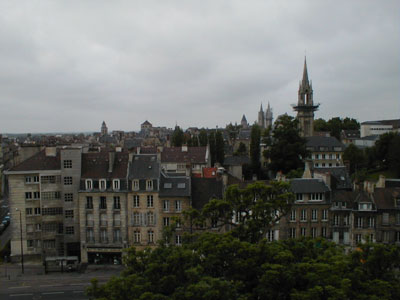 |
A view of Caen from the Chateau Ducal (William the Conqueror's castle/fortress).
|
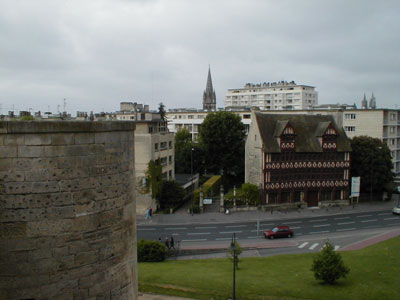 |
Another view of Caen from the Chateau. A very old building can be seen on the right.
|
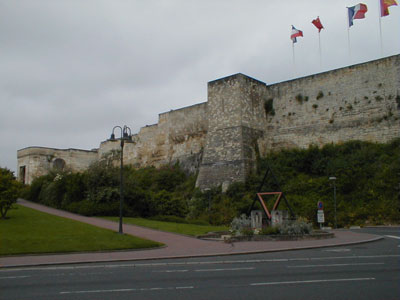 |
A view of the fortress from the street. It is one of the largest fortified enclosures in Europe.
|
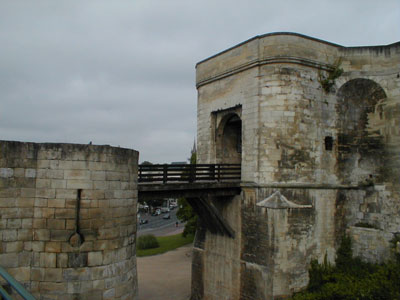 |
Ye Olde Drawbridge. The mechanisms were ancient and formidable.
|
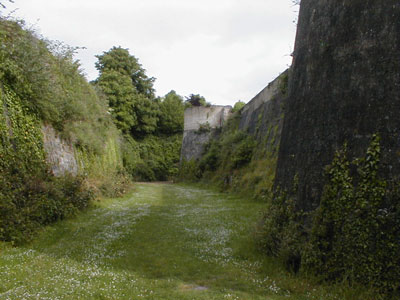 |
People were walking their dogs and jogging in the dry moat which separates the outer walls of the fortress from the inner walls of the castle/residency. The walls are impressively high when you are in there! We couldn't imagine trying to wage an attack. And with the height of the walls, it is easy to feel that you are lost in a maze.
|
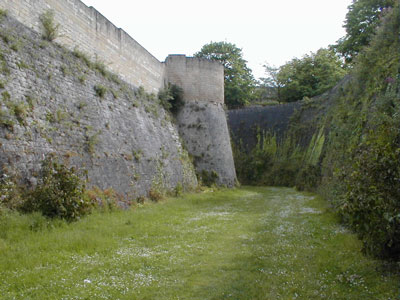 |
Another view of the moat, which has been maintained throughout its long history. Townspeople in the bordering houses used to dump their trash into the moat, but it was eventually cleaned up.
|
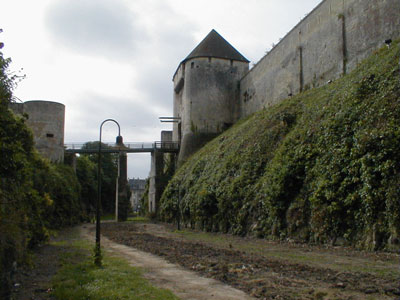 |
The way out! Strange mingling of modern and ancient.
|
|






